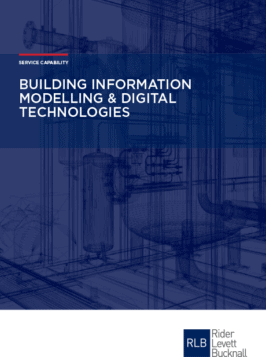The role of a quantity surveyor is to model complete costs, but budgets must be set long before an accurate or detailed building information model is available. How is RLB plugging in to the power of BIM to create better buildings? Chris Robinson, RLB Director in Victoria, and Derek Campbell, RLB’s IT Group Manager in Australia, ponder this question.
The modernisation of Phoenix Sky Harbor International Airport, the Edge Cultural Centre in Shanghai, Sydney’s fish market and the Hampton Gardens Secondary School in the United Kingdom are very different projects with one common denominator: each was modelled first in the digital world.
RLB has more than 300-plus project case studies where building information modelling, or BIM, helped us to estimate costs or prepare tenders, maintain a close watch on cashflow or monitor variations. We know BIM is a secret weapon that can help us exceed our clients’ expectations.
The role of the cost consultant is to capture information and uncover trends, benchmark and understand best practice to demonstrate to the client where their project sits on the continuum of efficiency. While BIM itself isn’t a cost-saving exercise, we know the more we use BIM, the greater the cost savings we can realise across the building lifecycle.
While some analysts predict BIM and digital twin technology will grow by up to 15 per cent a year for the next five years, the market still faces significant challenges. BIM has been held back by a lack of defined regulation and standards, expertise and skills, not to mention industry resistance and interoperability issues.
The size of the global BIM market:
- $5.2 billion in 2019
- $15.9 billion by 2027
- 15.2% predicted compound average growth rate from 2020 to 2027
Source: Building Information Modeling Market Size | BIM Market Analysis – 2027 (alliedmarketresearch.com)
Some governments are attempting to close the gap with investment programs or mandates. The Singaporean Government, for instance, requires BIM submissions for building projects of more than 5,000 square feet (464 sqm). The UK Government mandated BIM Level 2 on all government projects in 2018, with PwC estimating this could save the £400m a year – US$533 million*. But these examples remain rare. Despite governments being among the world’s biggest consumers of construction, few have developed comprehensive data management plans for BIM.
Commercial incentives are also absent. BIM plays a big role in reducing building lifecycle costs, but this does not always align with many favoured business models, and in particular where the building is passed from developer to owner.
Developers with a build and operate model, those that must construct to strict standards, or are delivering replicable projects – like schools, hospitals or high-rise apartments – are motivated to use BIM. But many of those developing bespoke buildings remain unsold on BIM’s benefits.
While the obstacles are obvious, there are hidden opportunities that can deliver benefits beyond an individual building. In typically siloed property companies, a great divide separates the development and operations divisions. BIM offers a holistic approach to design, procurement, construction and operations – and in an industry with an intractable productivity problem, we must embrace innovative ways of working.
BIM offers a holistic approach to design, procurement, construction and operations – and in an industry with an intractable productivity problem, we must embrace innovative ways of working.
RLB sees BIM as a key collaboration tool. Budgets are usually set long before the BIM model is properly established but accurate estimating relies on high quality historical data. The use of BIM information from previous projects can materially improve the quality of data used to prepare high level cost budgets on new projects.
With the help of BIM, we work as a core part of the design team to extract model data from the earliest stage. Armed with that data, we turn to our in-house specialist software to link model parameters, identifying efficiencies and productivity opportunities.
ROSS 5D – which represents the five dimensions of space, plus time and cost – helps RLB’s cost consultants prepare accurate estimates and bills of quantities from BIM models, as well as other information sources like 2D and 3D CAD drawings, illustrations, schedules and project documentation. ROSS 5D uses the concept of modularity to build libraries of common objects that simplify project modelling.
Complete costings can be prepared from minimal project information and refined as the project progresses. We can analyse alternative scenarios to cut costs and deliver more efficient and environmentally-sustainable buildings.
At the same time, our inhouse project and contract management software RLB Pulse offers a real-time picture of budgets, expenditures and financial risks. RLB Pulse allows us to manage and report on development proposals, contracts, payments and variations, and ties in with ROSS 5D for benchmarking.
At the global level, the power of big data is behind an ambitious benchmarking project: the RLB Global Benchmarking Platform. Gathering granular cost information from the thousands of active projects our team work on each week, we have established common cost standards, based on the International Construction Measurement Standards, to gain greater oversight of cost ranges across markets. This project is central to our global strategy to strengthen connections between offices, standardise our benchmarking and ensure our teams have access to the up-to-the-minute data.
As we experiment with a range of emerging technologies – augmented and virtual reality, drones, 3D printing, blockchain and artificial intelligence – we continue to invest in research, upskilling and in-house software.
Ultimately, the uptake of technological solutions will be driven by the digital natives that are entering our industry and profession. McKinsey & Company has found the construction industry is among the least digitised sectors**, but this is changing. Tech-savvy young people don’t want to spend their days chained to a desk. They expect to use digital technology to solve problems, reduce risk, improve efficiency and make their jobs easier. This, in turn, will help us deliver better value for money and bring imagination to life.
* Data point is here FYI: BIM benefits quantified for the first time | BIM+ (bimplus.co.uk)
** Data point is here FYI: Imagining construction’s digital future (mckinsey.com)
FURTHER INFORMATION:



